The ability to gain valuable information by analyzing how objects interact with different wavelengths of light is invaluable in various fields. While color is a key player in providing such information, polarization, which refers to how the electric field oscillates as light travels, holds a wealth of untapped data. Despite its potential, polarization imaging has mostly been limited to bulky and complex laboratory setups involving waveplates and polarizers. However, researchers at the Harvard John A. Paulson School of Engineering and Applied Sciences (SEAS) have now introduced a breakthrough in the form of a compact, single-shot polarization imaging system.
Pioneering a Compact Imaging System
This innovative imaging system developed by the team at SEAS requires just two thin metasurfaces, making it a game-changer in the field of polarization imaging. The system has the capability to provide a comprehensive picture of polarization in a range of applications, from medical imaging to augmented reality systems and smartphones. Published in Nature Photonics, the research outlines the significant advancements made through this technology, offering endless possibilities for real-time medical imaging, material characterization, machine vision, target detection, and more. The system eliminates the need for moving parts or bulky polarization optics, marking a new era in the realm of advanced imaging technologies.
Traditionally, polarization imaging techniques required an intricate set-up involving multiple rotating plates and polarizers to capture a series of images for analysis. However, the simplified system created by the researchers at SEAS uses two ultra-thin metasurfaces to achieve the same results. One metasurface is responsible for illuminating the object with polarized structured light, while the other metasurface captures and analyzes the changes in polarization to construct the final image in a single shot. This groundbreaking technique allows for real-time advanced imaging, a crucial feature for applications such as endoscopic surgery, facial recognition in smartphones, and eye tracking in AR/VR systems.
By combining the concepts of structured light and polarized imaging, the researchers have designed a revolutionary system that captures intricate polarization information with unmatched efficiency. The use of nanoengineered metasurfaces in place of conventional optical components has streamlined the design, making the system more accessible for widespread adoption in various applications requiring advanced imaging. This groundbreaking development opens up a whole new realm of possibilities in fields such as medical diagnostics, material classification, and pharmaceuticals.
The single-shot and compact nature of the polarization imaging system developed by the team at SEAS provides a promising pathway for future advancements in the field of imaging technology. By harnessing the power of structured light and polarized imaging, this innovative system has the potential to revolutionize how we gather valuable information from the interaction of light with objects. With the integration of machine learning algorithms, the applications of this technology can be expanded even further, offering new opportunities for research and innovation in a wide range of fields.
The breakthrough in polarization imaging by the researchers at SEAS represents a significant leap forward in the world of advanced imaging technologies. By introducing a compact and efficient system that eliminates the need for bulky optical components, this innovation has the potential to revolutionize various industries and pave the way for new discoveries in the realm of imaging. As we continue to push the boundaries of what is possible with polarization imaging, the future holds endless possibilities for advancements in medicine, technology, and beyond.


Leave a Reply
You must be logged in to post a comment.